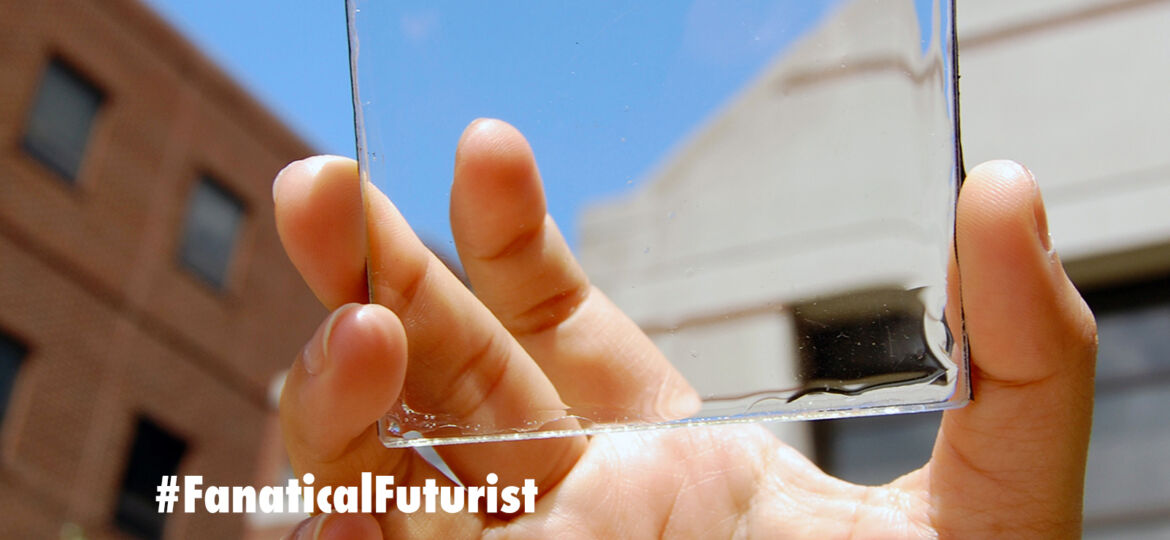
WHY THIS MATTERS IN BRIEF
As more materials become capable of producing and storing their own energy companies will be able to wean themselves off fossil fuels faster, and develop innovative new products.
Transparent solar cells and films that can be applied to any type of surface, even windows, and generate solar power, represent a massive source of untapped renewable energy and could harvest as much power as their bigger, bulkier rooftop solar units, say scientists in a report published in Nature Energy.
Led by engineering researchers at Michigan State University, the authors argue that widespread use of such highly transparent solar applications, together with the rooftop units, could nearly meet almost all of the US’s electricity needs, and drastically curtail the use of fossil fuels in the process.
See it in action
“Highly transparent solar cells represent the future for new solar applications,” said Richard Lunt, the Johansen Crosby Endowed Associate Professor of Chemical Engineering and Materials Science at MSU. “We analysed their potential and show that by harvesting only invisible light, these devices can provide a similar electricity-generation potential as rooftop solar while providing additional functionality to enhance the efficiency of buildings, automobiles and mobile electronics.”
Lunt and colleagues at MSU have pioneered the development of what’s known in the business as a “transparent luminescent solar concentrator,” a kind of transparent film that when placed on a window can generate solar energy without interrupting the view. The thin, plastic like material can also be used on buildings, car windows, cell phones or other devices, whether it’s a clear, transparent surface, or not, and as such its applications are almost limitless.
In the future, for example, it’s conceivable that these solar concentrators could be part of an overall energy mix that, when combined with traditional solar, for example, could be applied to electric cars in order to reduce the number of Lithium Ion batteries they need. Or, when combined with other advanced composites, like the ones being developed by Lamborghini, they could help automotive companies get rid of batteries all together. And the same could be said for buildings, factories, houses, and, so on…
The solar harvesting system uses organic molecules developed by Lunt and his team to absorb invisible wavelengths of sunlight. The researchers can “tune” these materials to pick up just the UV and the near infrared wavelengths that then convert this energy into electricity.
Meanwhile moving global energy consumption away from fossil fuels will require such innovative and cost-effective renewable energy technologies. Only about 1.5 percent of the world’s electricity needs are met by solar today but that number is ramping up fast, especially as solar is now the cheapest form of electricity in more that 58 countries in the world.
In terms of overall electricity potential though the authors note that there is an estimated 5 billion to 7 billion square meters of glass surface in the United States alone, let alone all the other surfaces their new film could be applied to. And with that much glass to cover, they argue that transparent solar technologies have the potential to supply more than 40 percent of all of the US’s energy needs, which is the same number touted by companies who sell rooftop solar units, a fact that isn’t lost on Lunt.
“The complimentary deployment of both technologies,” Lunt said, “could get us close to 100 percent of our demand if we also improve energy storage.”
Lunt said highly transparent solar applications are recording efficiencies above 5 percent, while traditional commercial solar panels are about 15 percent to 18 percent efficient, although at the cutting edge of solar panels this efficiency is now reaching beyond 27 percent. Although transparent solar technologies will never be more efficient at converting solar energy to electricity than their opaque counterparts, they can get close and offer the potential to be applied to a lot more additional surface area, he said.
Right now, transparent solar technologies are only at about a third of their realistic overall potential, Lunt added.
“That is what we are working towards,” he said. “Traditional solar applications have been actively researched for over five decades, yet we have only been working on these highly transparent solar cells for about five years. Ultimately, this technology offers a promising route to inexpensive, widespread solar adoption on small and large surfaces that were previously inaccessible.”
The work was funded by the National Science Foundation and the US Department of Education.

















Interesting! But not the first time have heard of clear solar cells.